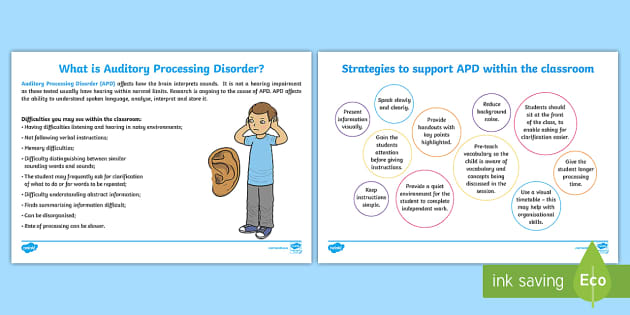
Premature and/or traumatic birth history.There is no single cause of auditory processing disorder however, it is linked to risk factors such as (Musiek and Chermak, 2009): What Causes an Auditory Processing Disorder? Up to 5 percent in school-aged children according to the National Institutes of Health.Ī 2:1 ratio of boys to girls has also been cited. Some research has suggested a prevalence of 2-3 percent in the pediatric population (Chermak and Musiek, 1997), with other estimates at 3-5 percent (Santucci cited in Matson, 2005). The exact prevalence of auditory processing disorder is variable given the wide definitions of auditory processing and how it is measured in different areas. How Common Is an Auditory Processing Disorder? In adults, neurological disorders such as stroke, tumors, degenerative disease (such as multiple sclerosis), and head trauma can contribute to APD. It is likely that many processes and problems contribute to APD in children. Children with APD experience difficulties in less-than-ideal (noisy) listening situations and may have difficulties with reading, spelling, attention, and language problems.ĪPD is common in older adults, particularly when hearing loss is present. Who Is Affected by APDs?ĪPD is often associated with various learning disabilities. Individuals often need more time to process auditory instructions, they “mishear” information and look for visual cues to help fill in the missing auditory information. What Are the Signs and Symptoms of an Auditory Processing Disorder?Ĭhildren and adults with APD often report difficulty hearing in background noise, in rooms that reverberate (echo) and/or other less-than-ideal listening situations. This difficulty becomes more noticeable in noisy or challenging listening environments or when listening to complex information. Individuals with auditory processing disorders may not perceive subtle differences in sounds of words even though the sounds are loud enough. Broadly, auditory processing disorders negatively impact the brain’s interpretation of sounds.

APDs affect the auditory areas of the brain.Īn auditory processing disorder is a broad term used to describe a variety of different auditory challenges rather than a single event.
AUDITORY PROCESSING DISORDER ASHA PROFESSIONAL
Using Technology to Improve Auditory-Based Learning Deficit OutcomesĮarn as many as 2.95 ASHA CEUs (29.5 professional development hours) for this event.Auditory processing disorders (APDs) are referred to by many names: central auditory processing disorders, auditory perceptual disorders, and central auditory disorders.School-Based Services for Students with CAPD.How Music Training Impacts Brain and Cognitive Development.Differential Diagnosis of CAPD and ADHD.Developmental and Neuropsychiatric Disorders and CAPD.


Auditory Interventions for Children with Auditory Processing Disorders.APD Diagnosis: The Advantages and Limitations of APD Assessments.This conference covers the latest research and findings on topics including: We hope you’ll join us in taking advantage of this unique ASHA learning opportunity.
AUDITORY PROCESSING DISORDER ASHA REGISTRATION
Early Bird Registration ends February 26, 2014. Learn more about how CAPDOTS™ helps clients coping with CAPD in our new videoĮarn professional development credits from the convenience of your office or home. This information packed online event includes access to real-time sessions with conference speakers and post-conference access (for two additional weeks) to: recorded sessions, chat transcripts and discussion boards. CAPD: Clinical Practices and the Science Behind ThemĬAPDOTS™ is delighted to be the Ultimate Sponsor for this ASHA conference that brings together leading scientists and clinicians from around the world to give Audiologists and SLPs access to cutting-edge research and the best treatment approaches for clients coping with central auditory processing disorder (CAPD).


 0 kommentar(er)
0 kommentar(er)
